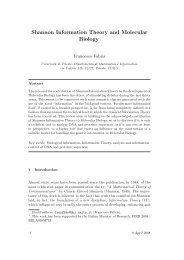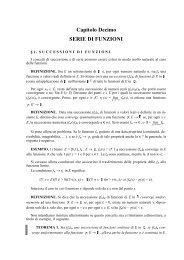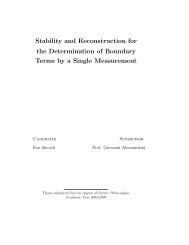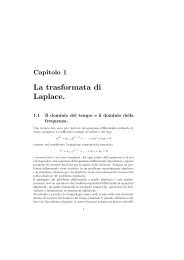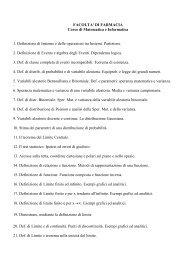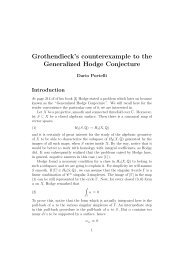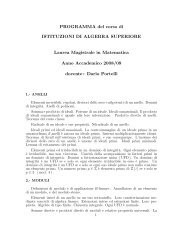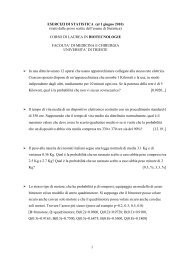INTRODUCTION TO ALGEBRAIC GEOMETRY Note del corso di ...
INTRODUCTION TO ALGEBRAIC GEOMETRY Note del corso di ...
INTRODUCTION TO ALGEBRAIC GEOMETRY Note del corso di ...
Create successful ePaper yourself
Turn your PDF publications into a flip-book with our unique Google optimized e-Paper software.
44 Mezzettithere exists F such that F(P) ≠ 0 and V (F) ⊃ Y ′ . So P ∈ Y \ V (F) ⊂ Y \ Y ′and Y \ V (F) is an affine open neighbourhood of P in Y \ Y ′ = X 0 ⊂ X.□6. The Veronese maps.Let n, d be positive integers; put N(n, d) = ( ) (n+dd − 1. <strong>Note</strong> that n+d)d isequal to the number of (monic) monomials of degree d in the variables x 0 , . . ., x n ,that is equal to the number of n+1–tuples (i 0 , . . ., i n ) such that i 0 +...+ i n = d,i j ≥ 0. Then in P N(n,d) we can use coor<strong>di</strong>nates {v i0 ...i n}, where i 0 , . . ., i n ≥ 0 an<strong>di</strong> 0 + . . . + i n = d. For example: if n = 2, d = 2, then N(2, 2) = ( )42 − 1 = 5. In P5we can use coor<strong>di</strong>nates v 200 , v 110 , v 101 , v 020 , v 011 , v 002 .For all n, d we define the map v n,d : P n → P N(n,d) such that [x 0 , . . ., x n ] →[v d00...0 , v d−1,10...0 , . . ., v 0...00d ] where v i0 ...i n= x i 00 x i 11 . . .x i nn : v n,d is clearly a morphism,its image is denoted V n,d and called the Veronese variety of type (n, d). Itis in fact the projective variety of equations:(∗){v i0 ...i nv j0 ...j n− v h0 ...h nv k0 ...k n, ∀i 0 + j 0 = h 0 + k 0 , i 1 + j 1 = h 1 + k 1 , . . .We prove this statement in the particular case n = d = 2; the general case issimilar.First of all, it is clear that the points of v n,d (P n ) satisfy the system (∗).Conversely, assume that P[v 200 , v 110 , . . .] ∈ P 5 satisfies the equations (∗), whichbecome:⎧v 200 v 020 = v1102v ⎪⎨ 200 v 002 = v1012v 002 v 020 = v0112v 200 v 011 = v 110 v 101⎪⎩ v 020 v 101 = v 110 v 011v 110 v 002 = v 011 v 101Then, at least one of the coor<strong>di</strong>nates v 200 , v 020 , v 002 is <strong>di</strong>fferent from 0.Therefore, if v 200 ≠ 0, then P = v 2,2 ([v 200 , v 110 , v 101 ]); if v 020 ≠ 0, thenP = v 2,2 ([v 110 , v 020 , v 011 ]); if v 002 ≠ 0, then P = v 2,2 ([v 101 , v 011 , v 002 ]). <strong>Note</strong> that,if two of these three coor<strong>di</strong>nates are <strong>di</strong>fferent from 0, then the points of P 2 foun<strong>di</strong>n this way have proportional coor<strong>di</strong>nates, so they coincide.We have also proved in this way that v 2,2 is an isomorphism between P 2 andV 2,2 , called the Veronese surface of P 5 . The same happens in the general case.If n = 1, v 1,d : P 1 → P d takes [x 0 , x 1 ] to [x d 0 , xd−1 0 x 1 , . . ., x d 1]: the image iscalled the rational normal curve of degree d, it is isomorphic to P 1 . If d = 3, wefind the skew cubic.Let now X ⊂ P n be a hypersurface of degree d: X = V P (F), withF =∑i 0 +...+i n =da i0 ...i nx i 00 . . .x i nn .



